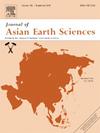印度支那地体俯冲相关岩浆作用:来自泰国中部三叠纪火山岩的启示
IF 2.7
3区 地球科学
Q2 GEOSCIENCES, MULTIDISCIPLINARY
引用次数: 0
摘要
泰国中部萨拉武里—罗布武里地区的火山岩主要由3个主要单元组成:以斜长石和角闪石为主,具有典型斑状结构的玄武岩-安山岩单元,以斜长石、角闪石和石英为主的安山岩单元,以及以石英、斜长石、钾长石和白云母为主的流纹岩单元。整体岩石组成表明,玄武岩-安山岩岩起源于低钾钙碱性岩浆,由部分熔融程度较高的俯冲板块熔融而成。安山岩和流纹岩可能与高钾钙碱性岩浆有区别。所有火山岩可能都位于大陆弧构造环境中。玄武岩-安山岩单元和安山岩单元的锆石U-Pb年龄分别为213.4±0.5 Ma和203.5±0.3 Ma,表明晚三叠世弧火山作用是由俯冲作用形成的。本文章由计算机程序翻译,如有差异,请以英文原文为准。

Subduction-related magmatism in the Indochina Terrane: Insights from Triassic volcanic rocks in Central Thailand
The volcanic rocks in the Saraburi–Lop Buri area of Central Thailand consist of three main units: a basaltic–andesitic rock unit predominantly composed of plagioclase and hornblende with a typical porphyritic texture, an andesitic rock unit usually composed of plagioclase, hornblende and quartz, and a rhyolitic rock unit dominated by quartz, plagioclase, K-feldspar, and muscovite. Whole-rock compositions suggest that basaltic–andesitic rocks originated from low-K calc-alkaline magma via melting of a subducted slab with a relatively high degree of partial melting. The andesitic and rhyolitic rocks are possibly differentiated from high-K calc-alkaline magmas. All volcanic rocks are probably emplaced in a continental arc tectonic setting. The zircon U–Pb ages of the basaltic–andesitic rock unit and andesitic rock unit are 213.4 ± 0.5 Ma and 203.5 ± 0.3 Ma, respectively, indicating that the arc volcanism resulted from subduction during the Late Triassic.
求助全文
通过发布文献求助,成功后即可免费获取论文全文。
去求助
来源期刊

Journal of Asian Earth Sciences
地学-地球科学综合
CiteScore
5.90
自引率
10.00%
发文量
324
审稿时长
71 days
期刊介绍:
Journal of Asian Earth Sciences has an open access mirror journal Journal of Asian Earth Sciences: X, sharing the same aims and scope, editorial team, submission system and rigorous peer review.
The Journal of Asian Earth Sciences is an international interdisciplinary journal devoted to all aspects of research related to the solid Earth Sciences of Asia. The Journal publishes high quality, peer-reviewed scientific papers on the regional geology, tectonics, geochemistry and geophysics of Asia. It will be devoted primarily to research papers but short communications relating to new developments of broad interest, reviews and book reviews will also be included. Papers must have international appeal and should present work of more than local significance.
The scope includes deep processes of the Asian continent and its adjacent oceans; seismology and earthquakes; orogeny, magmatism, metamorphism and volcanism; growth, deformation and destruction of the Asian crust; crust-mantle interaction; evolution of life (early life, biostratigraphy, biogeography and mass-extinction); fluids, fluxes and reservoirs of mineral and energy resources; surface processes (weathering, erosion, transport and deposition of sediments) and resulting geomorphology; and the response of the Earth to global climate change as viewed within the Asian continent and surrounding oceans.
 求助内容:
求助内容: 应助结果提醒方式:
应助结果提醒方式:


